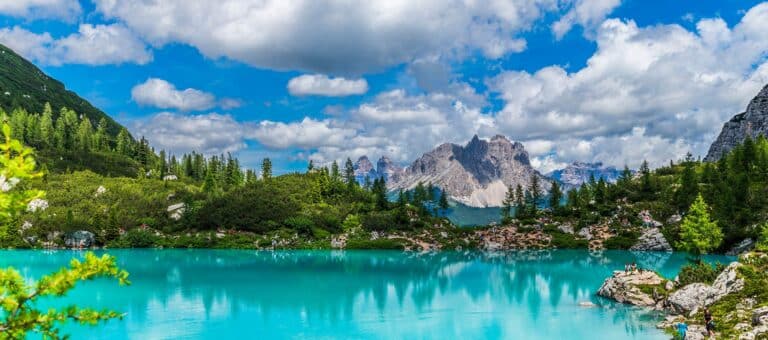The big-beauty lakes are Maggiore, Como, and Garda. There are also smaller, hidden lakes. All were formed by glaciers millennia ago. Prehistoric people inhabited the region and, much later, the Romans moved in. For us, there is the bonus of culture, cuisine, and heritage. Lush gardens hug the shores all the way to Switzerland.
Vineyards, olive trees, palm trees, bougainvillea, and other Mediterranean plants abound. Magnificent churches, sanctuaries, and castles from the Middle Ages dot the landscape. Funiculars, narrow-gauge railroads, boats, and cable cars offer views. In the 18th century, the lake region was part of the Grand Tour—a visit was deemed necessary for a proper, upper-class education.
The shores have been a favorite of writers, musicians, and artists for thousands of years. Goethe, Byron, Toscanini, Hesse, Paul Klee, and Hemingway all created here. Today, George Clooney calls the North Lake region of Italy home, and his high-profile guests are mesmerized by the beauty. An Italy vacation in the Northern Lakes is sublime.

Share this Graphic On Your Site
Lake Como
Whether you stay or take a day-trip from Milan, Como is the most spectacular of the major lakes. Lush hillsides climb to snow-tipped Alps, and the lake is set prettily in the middle. Villages hug the shoreline, including elegant Bellagio and Varenna. The town of Como, on the southern tip, was founded by Julius Caesar as a resort town, and alpine fort, in the 1st century AD. The 18th century Austrian take-over passed along a vibrant café culture. You might also get a kick out celebrity-spotting. George Clooney’s family, and guests, creates a buzz.Lake Maggiore
Just 34 miles from Milan’s airport, Maggiore has brilliant shores filled with camellias, azaleas, and verbena. (The Roman name for this lake was Verbanus.) Head to the village of Arona, and climb inside the statue of Cardinal Borromeo. Look at the lake through his eyes—he was their patron saint. At the center of the lake, the Borromean Islands are near the resort town of Stresa. Delight in the natural grottoes, and then explore 17th century Pallazo Borromeo and its gardens. Two miles west of Cannobio, a market town near Switzerland, you can hike to the dramatic gorge and tumbling waterfall of Orrido di Sant ‘Anna.Lake Sorapis
Deep in the Dolomites, high-elevation Lake Sorapis is a vision. (If you’re a hiker in great shape, consider going to the summit.) The water color ranges from deep blue to milky turquoise. The white Dolomites, which resemble marble, rise from the lake, and green pastures surround all. With its towering pinnacles and lake vistas, this is one of the most spectacular spots in Europe. The lake can only be reached on foot, and there is a clear path. It’s quite high in elevation so if you choose to hike to the top, go slowly. (This path is not for anyone who is uneasy about heights.) You can be amazed by the lake without climbing the mountain, and the sheer white cliffs, green hills, and turquoise waters are a must for nature lovers.Lake Iseo
In the center of the Franciacorta wine region and foodie heaven, local trattorias serve up fresh dishes with fish and sparkling wines. The area round Iseo has tall mountains, waterfalls, and a small island, Monte Isola. There are scores of fishing villages on the shores, giving this area a homey, less-glitzy, feel. The small town of Sulzano makes a good jumping-off place to explore the area around the lake. On the east bank, a road leads to the village of Cisiano, about three miles from Marone. Rock formations shaped like spires are topped by boulders and known by residents as “fairies of the forest.” This area is low-key and lovely.Lake Garda
The largest lake in Italy, Garda is between Venice and Milan on the edge of the Dolomites. Francis of Assisi founded his monastery on the largest island here, Isola del Garda, in 1220. Olive trees, hardy lemons, parasol pines, and the Canary Island Date Palm grow in abundance. Winds rush down the mountains in the morning, and go back up at night. There are so many types of winds, that they have different names. Go to Sirmione and discover Scaligeri Castle, one of the most complete and well-preserved castles in Italy, and then take a trail to prehistoric rock art.Lake Lugano
Just a short distance from Como and Maggiore, Lake Lugano is tucked near the Swiss border. The area is a dynamic mix of cultures, and more than a thousand types of exotic, flowering plants hug the shores. In the town of Lugano, oddly, is a statue of George Washington raised by a Swiss-Italian admirer in the 19th century. (Visit the Chiesa di Santa Maria di Loreto church.) There’s also an ancient olive grove near the lake called Sentiero dell’olivo. Explore, and find hidden grottoes.Lake Orta
The smallest lake, Orta is a hidden gem. The main town, Orta San Giulio, is romantic—picture winding lanes, rustic houses, and ancient walls. It’s also a literary hideout for notable poets and writers. The medieval village is known for Sacro Monte, a UNESCO-listed place of pilgrimage and worship, overlooking the lake. Isola San Giulio is an island in the lake, accessible only by boat, and home to the 12th century Basilica di San Giulio. Milan airport is 24-miles away, which makes this a nice, one-day trip from the city.Ancient Romans loved visiting the lakes in Northern Italy as much as we do—the scenery and mild climate are incomparable. Fall into the spellbinding wonder of vacationing on Italy’s Northern Lakes and remember how to breathe…
If you’ve been dreaming about abundance and joy, let your Destination Expert that you’re imagining Italy’s Northern Lakes!









